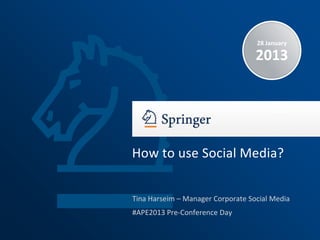Ape 2013 23012013
- 1. ALTERNATIVE METRICS. THE END OF THE IMPACT FACTOR AS WE KNOW IT? #APE2013 http://about.me/martijnroelandse
- 2. Who am I? 2 #APE2013 2000 ĻC 2003 PhD Neurobiology Friedrich Miescher Institute, Basel 2003 ĻC 2005 Postdoc Centre for Neurogenomics and Cognitive Research, Amsterdam 2005 ĻC 2008 Postdoc Netherlands Institute for Neuroscience, Amsterdam 2008 ĻC 2010 Associate publisher B2B Springer Media BV, Houten 2010 - current Publishing Editor STM Springer Science+Business Media BV, Dordrecht
- 3. Research output per country 3 #APE2013 7 2.0 40 Millions Millions Millions 6 5 1.5 30 4 2005 1.0 2006 20 2006 3 2 2009 2010 2010 0.5 10 1 0 0.0 0 researchers articles citations Sources: OECD MSTI: all population data 2010, all research data 2009, all GERD data 2010 except Germany (2009), with extrapolation where appropriate and where World totals are the sum of data for all countries with available data. WIPO Statistics Database: all patents data 2009. Scival Spotlight: all Competencies data 2010. Scopus: all Articles, Citations and Highly-cited articles data 2010. ScienceDirect: all Usage data 2010.
- 4. The rise of the mega-journals 4 #APE2013 #Articles - Launched June 2006 12000 10000 - Biology and Medicine 8000 - Rejection rate: 15% 6000 4000 - Jan 2012: Article 30.000 published 2000 0 - 2010 Impact Factor: 4.351 2007 2008 2009 2010 2011
- 5. #APE2013 5 Impact Factor Once published, the impact of their contribution to science is mostly assessed on the basis of out-of-date mechanisms such as the impact factor. However, the actual influence of their contribution on the journal's performance will only be visible for after another 2-3 years. A = the number of times that articles published in 2006 and 2007 were cited by indexed journals during 2008. B = the total number of "citable items" published by that journal in 2006 and 2007 2008 impact factor = A/B.
- 6. #APE2013 6 Which article made a bigger impact? ? Article published in a top-tier journal with ĄŪ0ĄŊ citations after 2 years ? Article published in a lower impact journal with tens of citations
- 7. Research dissemination channels have changed 7 #APE2013 ? Scholarly citations ? Non-scholarly citation ? News coverage ? Twitter, Facebook, Google+ ? Blogs, Wikipedia ? Post-publication recommendations ? Faculty of 1000 ? Mendeley, ResearchGate, Academia.edu, Papers
- 8. Growth of non-scholarly citations 8 #APE2013 10 7 4.4 3.7 4.37 5 2.63 % 0 Facebook twitter Pinterest Reddit Q&A sites LinkedIn -5 average monthly change, 1st Sep - 1st Dec '12 -10 -8 200,000 187408 150,000 absolute numbers Sept '12. 100,000 50,000 24052 2077 2195 471 833 73 174 0 Facebook twitter Blogs Google+ Pinterest Reddit Q&A sites LinkedIn
- 9. #APE2013 9 Which article made a bigger impact? ? Article with tens of citations ? Article widely discussed in the social web ? Article with lots of downloads
- 10. #APE2013 10 Article Level Metrics Article-Level Metrics (ALMs, altmetrics, alternative metrics) are not just about citations and usage. The concept refers to a whole range of measures which might provide insight into ĄŪimpactĄŊ or ĄŪreachĄŊ. Collectively as a suite, ALMs aims to measure research impact in a transparent and comprehensive manner.
- 11. ALM @ PLoS 11 #APE2013 ? Key importance: Findability, sharability, ci tability, comments ? Real-time listing: ? Citations ? Usage ? Social Impact ? Post-pub review comments
- 12. Other ALM examples (I) 12 #APE2013 BioMed Central IOP Nature HighWire
- 13. Other ALM examples (II) 13 #APE2013
- 14. Scholarly vs non-scholarly citations 14 #APE2013 40 Ą°Tweets can predict 35 highly cited articles 30 within the first 3 days of 25 article publication Cited 20 15 10 5 0 0 5 10 15 20 25 30 35 40 45 Social Sources: Cited: Top 500 articles published in 2012 and cited in 2012 using Thompson Scientific Journal Citation Index for Springer journals in neuroscience. Social: Top 500 articles for Springer journals in neuroscience mentioned in the social web using Altmetrics. All data 01/12/2012. Eysenbach G Can Tweets Predict Citations? Metrics of Social Impact Based on Twitter and Correlation with Traditional Metrics of Scientific Impact J Med Internet Res 2011;13(4):e123
- 15. Concluding ĻC Article Level Metrics 15 #APE2013 ? A more accurate evaluation of scholarly performance ? Show dissemination of an article through scholarly and non-scholarly communication ? A new benchmark for employers, funders, potential collaborators ? Provide filters to select those articles most relevant for their work
- 16. QUESTIONS? #APE2013 http://about.me/martijnroelandse
















